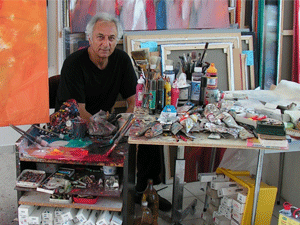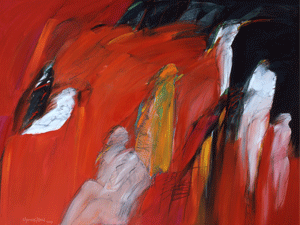The World is On the Tip of His Brush
- Written by Admin TOA
- Published in Culture & Art
Turkey has not sent only unskilled workers to Europe, even if the stereotype image of the Turk is that of an immigrant worker doing manual labor. Mehmet Guler is one of our painters esteemed for his career and works of art. He has displayed his canvases at exhibitions, biennials, and museums all around the world.
With the freelance artist, who has lived in Kassel since 1977, we discussed his art and his life in Germany, to which he came at age 33.

Mehmet Guler.
Can you share with us your story of coming to Germany and why you decided to stay?
I was a member of the faculty of what is today the Department of Fine Arts of Gazi University, and after winning a scholarship from the Ministry of Education, I came here to complete my specialization. After completing my studies at the Kassel Academy of Fine Arts with distinction I returned to my position in Turkey. Unfortunately, in the political atmosphere of those days politicians and administrators were more concerned with the political allegiance rather than the competence of their appointees.
Instead of people that have educated themselves and could contribute to the development and enlightenment of the country, they favored people with the same ideological notions who would not go beyond the authority of their leaders. Although having the opportunity of staying in Germany, I had returned to Turkey and was waiting for a position during a period when political appointments were the order of the day. After waiting for a year and after all my efforts to find a position failed, I returned to Germany to work as a freelance artist.
Was the environment here better than in Turkey?
The question of the environment here being better than in Turkey, is something that you can answer differently, depending on how you define it, and with which concepts you make your judgment. Of course each environment has its pros and cons. The advantages of being an artist in Germany are being in a multicolored culture and the way an artist is provided with the ability to expand to the outside world more easily. But this also shouldn’t be perceived as a ready benefit that every artist can make use of.
How do you evaluate the interest in your work in Turkey?
I don’t think limiting this question to Turkey would be correct. The attention a work of art draws is connected to its achievement. If it’s original, people everywhere will be interested in it, not only in Turkey.
What drew you to painting?
Why does a child or a young person become interested in art, and choose it as the occupation of his life, his profession? I believe that the most important factor in this decision is the internal stimulus. In addition to this, you can list numerous factors, from being influenced by an artist or artistic work to the effects of family and environment.
I was interested in painting in grammar school in a distant corner of Anatolia, at a period where not even watercolors were known. I struggled to create something with the limited resources I had, or better, without any resources. After that, at every school I attended I set myself a new goal, and became who I am today. In short, I can explain my interest in painting as an internal impulse.
What kind of influence does your Turkish origin have on your paintings?
The language of art is universal. Essentially, in the process of creation, the nationality of the artist should not be a determining aspect. On the other hand, we also cannot say that the environment where the artist was born and raised does not have any influence on his expression. More than ever for an artist like me, who spent his first thirty years in the country where he was born, it is expected to see the traces of his culture in his interpretation and expression.
What are these marks? Until the mid 80s, the elements in my figurative paintings derived from the culture and environment of my country. Today, these elements are still present in my figurative and abstract paintings, but are more universal. You can also add my color choices to this.
You are an artist who has held exhibitions, in addition to Germany, in different countries around the world. At the beginning, did you think your involvement in painting would carry you to this level?
Involvement in art, the life of an artist, is like walking a dark path. You cannot see ahead. No artist is equipped with the gift and the privilege of seeing into the future. Nonetheless, the artist has to believe that the path he took is the right one and continue his efforts without deviating from it. The only requirement for success is believing in yourself, and renewing and exceeding yourself without making concessions to your persona. But this is also important to mention. Effort is sometimes not enough; the character and ability of the artist is also important.
Naturally I couldn’t foresee the position I am in today. But I always trusted in myself and in the future, and pursued my work with this belief, and continue to do so.
How do you compare the development of painting in the US and in Europe?
Europe and the US are two separate worlds. However, art does not recognize continents, countries, or borders and its language is universal. But the reflection of the lifestyle, culture, religion, traditions and customs, even the climate of the country, in art is natural. Because of this, we have to explicate the difference between individuals and not between continents or countries. Nonetheless, considering these individuals also form an entirety, we cannot deny that there might be differences between continents and countries. We should remember that the European culture goes back thousands of years, and America lacks this.

One of Guler's painting.
What is the turning point in your art? Is there an incident that had a major effect on you?
There haven’t been major turning points or discontinuities in my art. I can say that I have been consciously continuing my work since age 12. To be myself, not to imitate somebody else, never making concessions about things I believe in, to exceed myself and renew myself are my fundamental principles.
In general, you use people and nature as your inspiration. What do people and nature mean to you?
In my works of art I try to examine the encounter of people and different cultures, cultural influence, how culture is being affected, culture shock. These interest me as an individual as well as an artist. How can I examine and interpret something that I am not interested in?
Do you have a target audience? Or, is what motivates your painting your own happiness and pleasure in painting?
I do my art for myself. The artist has to enjoy his art himself first, and has to bring an interpretation. This forms the character of the artist. We can say it is the signature of the artist. This is in direct relation to the cultural intensity put into the process of creation. Thus, the role of the artist should be to pull the society to his level, and that is what should be. Not to descend to other peoples’ level merely in order to be favored by some people and circles, to make your work accepted by them.
Together with TAM, you held an exhibition in Essen. Do you have any plans for other exhibitions? What are your plans for the future? Are there other disciplines you’d like to try?
My exhibition in Essen was held following ones in Istanbul and Ankara, and shortly thereafter another exhibition was held in Bonn. Next in line is Berlin.
I believe that an artist has to work interdisciplinarily. Working and thinking in different fields enriches an artist’s interpretation and creativity. It will protect him from the danger of repeating himself. Although the oil paintings on canvas make up the major part of my creations, I also work in mixed technique, acrylic, engraving, xylography, design, and sculpture. I also have a book titled The Past in the Sun, published in December 2005 by Dunya Publishing in its Art/Projection Series.
WHO IS MEHMET GULER?
Mehmet Guler was born in Malatya in 1944. In 1965 he graduated from the Gazi Educational Institute, Department of Painting in Ankara. He worked as an art teacher in a number of teacher training colleges and worked as an assistant in the Painting Department of Gazi Educational Institute.
With a grant from the Turkish Ministry of Education, he went to Germany to complete his specialization. He graduated from the Academy of Fine Arts of the University of Kassel with the highest degree. He returned to Turkey in 1976, and lectured at Gazi College of Art for a year. Returning to Germany in 1977, he has since then lived and worked as freelance artist in Kassel.
Apart from collective exhibitions, biennial and triennial celebrations and art fairs, Mehmet Guler has held more than 155 individual exhibitions of his work in, among other locations: Texas, Vienna, Singapore, Helsinki, Rotterdam, and Berlin. His works are to be found in private and public collections and museums.
SELECTIVE AWARDS
1983 Award, Sedat Simavi Foundation, Visual Arts Award, İstanbul
1986 Award, International Graphic Triennial, Frechen - Germany
1990 Award, International Graphic Triennial, Frechen - Germany
1991 Award, International Graphic Contest, Bergamo - Italy
BIENNIAL S – TRIENNIALS
1974 International Graphic Biennial, Krakau, Poland
1974 International Graphic Biennial, Frechen, Germany
1975 MIR 75/30 OZN International Graphic Biennial, Slovenj-Gradec, Yugoslavia
1976 International Graphic Biennial, Frechen, Germany
1983 International Graphic Triennial, Frechen, Germany
1986 International Graphic Triennial Frechen, Germany
1989 Drawing '89, International Drawing Biennial, Cleveland, England
1990 International Graphic Triennial, Intergrafik Berlin, Germany
1990 International Graphic Triennial, Frechen, Germany
1996 12th International Drawing Biennial, Cleveland, England
1996 International Graphic Triennial, Frechen, Germany
1997 International Graphic Triennial, Cairo, Egypt
1999 International Graphic Triennial, Frechen, Germany
2000 International Graphic Triennial, Cairo, Egypt
(May 2006, 20th Issue)
Last modified onSaturday, 06 May 2017 10:07
Latest from Admin TOA
- Fat Sal’s Italian Specialties Welcomes Customers in Bayville, NJ with a Renewed Concept
- FFD Wood LLC Delivers Custom Woodwork Solutions from Long Island
- A Tax Expert in the U.S. Tax World: An Interview with Samet Oynamıs
- Announcing the 2025 Edition of the 100 Most Influential Turkish Americans
- “Sweet Coincidences” Featured on EKOL TV: A Life Story Woven with Love, Loyalty, and Cultural Heritage








